On our way to
Munich and Bavaria, we stopped first in
Darmstadt to visit another Hundertwasser apartment building called
Waldspiral:
In another part of Darmstadt we found Mathildenhohe, an art colony founded in 1899 when Grand Duke Ernst Ludwig brought together important Art Nouveau artists, including the famous Joseph Maria Olbrich. The goal was to develop modern and forward looking methods for construction and living. The artists had homes surrounding the compound.
 |
| (not mine) |
 |
| (also not mine) |
 |
| Hichzeitsturm by Joseph Maria Olbrich, 1907-09 |
We came across a few sculptures around town as well.
Next stop:
Plochingen for another Hundertwasser apartment building:
But there was more of interest here. Such as the sculpture:
And the peaks.
Still driving southeast, our next stop was Ulm. Famous for having the tallest steeple in the world (529.95 feet) and birthplace of Albert Einstein, the university has amassed quite a bit of sculpture on its unassuming campus.
 |
| Le Poete et sa Muse by Niki de Saint Phalle |
 |
| Four Open Rectangles Excentric by George Rickey, 1977 |
 |
| Adam and Eve by Niki de Saint Phalle |
Our home for the next week was outside Munich in Gilching. Actually Gilching was the name of the train station. I think the village was
Geisenbrunn. Train into Munich. Easy access to everywhere else. We began the next day in Munich at the
Neue Pinakothek.
The focus of this historic and important gallery is 18th and 19th century European paintings, which suited us just fine.
 |
| Don Quijote by Honore Daumier, c 1868 |
 |
| Street in Upper Norwood by Camille Pissarro, 1871 |
 |
| Summer's Day on the island of Norimoutier by Maurice Denis, 1903. |
 |
| Woman in Red Dress (Street in Asgardstrand) by Edvard Munch, c 1902-3 |
 |
| Woman in Armchair by Henri de Toulouse-Lautrec, c 1897 |
 |
| Plain near Auvers by Vincent van Gogh, 1890 |
 |
| Sunflowers by Vincent Van Gogh, 1888 |
 |
| The Weaver by Vincent van Gogh, 1884 |
 |
| Four Breton Women by Paul Gauguin, 1886 |
 |
| the Birth-Te tamari no atua by Paul Gauguin, 1896 |
 |
| Water Lilies by Claude Monet, c 1915 |
 |
| Agony by Egon Schiele, 1912. |
 |
| Margaret Stonborough-Wittgenstein by Gustav Klimt, 1905 |
 |
| The Sin by Franz von Stuck, 1893 |
There was more Art and sculpture around the museum and around town:
 |
| Julliet - gift from sister city Verona in 1974 |
 |
| Clouds by Michael Pendry in the Heilig Geist Kirche. |
 |
| Maximilian Joseph Graf von Montgelas by Karin Sander, 2005 |
 |
| Michael Jackson memorial |
 |
| Buscando la Luz by Eduardo Chillida, 1997 |
 |
| Present Continuous by Henk Visch, 2007-11 |
We headed north, the next day, aiming for
Nuremberg.
 |
| Miles of hops along the way. |
But on the way we saw signs for another Hundertwasser project: The
Kunst Haus and Brewery at Kuchibauer Tower in
Abensberg.
We found
Nuremberg to be a pretty artsy place.
 |
| by Arnaldo Pomodoro |
Germansche National Museum:
 |
| Portrait of Dürer's Mother Barbara nee Holper by Albrect Dürer, c 1490 |
Dürer lived his life in Nuremberg. Cradle to grave. And there were lots of Cranachs:
 |
| The Ill-Matched Couple by Lucas Cranach the Elder, c 1530 |
 |
| detail from Martyrdom of Saint Ursula by Nuremberg master c. 1510 |
 |
| The Red Necklace by Sepp Hilz, 1942 |
 |
| Lake Tegern landscape by August Macke, 1910 |
 |
| Head in Black and Green by Alexej von Jawlensky |
 |
| Two Girls by Max Pechstein, 1909 |
 |
| Bathers at the Beach by Erich Heckel, 1913 |
 |
| Interior with Two Girls by Ernst Ludwig Kirchner, 1908-1926 |
And we saw a few sculptures:
 |
| Kurt Klutentreter by Eva Maria Weber |


The next day we went south to Switzerland in search of more Hundertwasser. But first we had to stop on the German side of the Bodensee (Lake Constance). At the far east end is the tiny (1/4 sq. acre) island (connected by road-bridge and railway) town of Lindau. The first documented use of the name dates to 882, but one would suppose that it has been occupied for as long as humans were in the area. We got there early and missed the mobs of tourists that were sure to follow.
 |
| (on the way) |
 |
| Sketching the Bavarian Lion. |
 |
| Friederike and Lieber Augustin by Reinhold Petermann, 1982 |
There was an exhibition of Art by Emil Nolde at the Lindauer Stadtmuseum.
Photos were not permitted, but I was able to scrounge a few pics online:
We went around the eastern edge of the lake (and through a tiny strip of Austria) to the southern shore in Switzerland, to Thal and Hundertwasser's marketplace building, Alten Rhien. Though designed as a farmers' market, it soon turned into a private event space.
We thought we'd try driving through some Alps on the way back to Geisenbrunn.
South of Munich are a series of lakes that have always attracted the people of Bavaria, no less so the artists. Among them were members of the Fauve-inspired Blaue Reiter (Blue Rider) which came together in 1911 and lasted until 1914. Franz Marc had a place at Kochel am See, Campendonk was in Penzberg, while Wassily Kandinsky and his girlfriend Gabriele Münter bought a house in Murnau in 1908 where they were soon joined by Alexej von Jawlensky and the Countess Marianne von Werefkin.
In Murnau you can follow a trail identifying places that Kandinsky and Münter painted.
And then, of course, there was the Art of the town.
 |
| by Peter Vogece, 1977 |
 |
| Horvath Hat |
There were a couple of forgettable exhibits in the Schlossmuseum. Of course, not being able to take pictures does not help. Next was Kochel am See for the Franz Marc Museum where they also did not allow photographs. Since this was only announced in German, I got this shot of a Marc painting before I was reprimanded:
There were other artists represented besides Marc. Many were unidentified. But they couldn't stop me from shooting the sculptures.
 |
| Hommage an Franz Marc, 1995 |
 |
| Gehornte Schlange aufrecht II by Horst Antes, 2002-03 |
 |
| Ruhende by Hans Stangl, 1933 |
 |
| Kochel See |
It is a pretty area.
But the best surprise was the Buckheim Museum der Phantasie overlooking Starnburg See in Bernried.
Inside were vast galleries of German Expressionists, et al:
 |
| Am Waldteich by Erich Heckel, 1911 |
 |
| Kopf in Blau by Alexej von Jawlensky, 1920 |
Lots of Kirchners:
 |
| Madchenakt auf bluhender Wiese by Ernst Ludwig Kirchner, 1909 |
 |
| Araber by Emil Nolde, 1920 |
 |
| Marine Noordwijk (Reiter am Strand) by Max Beckmann, 1946 |
Downstairs were lots of characters created by Angelika Littwin-Pieper:

But I couldn't find out who did these beauties:

CLICK HERE FOR MORE.
The following day I went West to Augsberg. Home of Leopold Mozart and Bertholt Brecht. Also home to the Glaspalast, a former textile mill, this building now houses the Staadstgalerie Modern Kunst (a branch of the Pinakotek in Munich), H2 Contemporary Art Galleries, Gallery Noah, and Kunstmuseum Walter.
The first three had little to offer. Though there are claims of paintings by real artists, the only thing I saw on the first two floors were unappealing contemporary. Upstairs, the Gallery Noah had huge paintings by Stefan Szczesny:
 |
| Badende am See by Stefan Szczesny, 1984 |
 |
| Im Licht des Sudens by Stefan Szczesny, 2008 |
The Kunstmuseum Walter represents the collection of Ignaz Walter, civil engineer and global construction magnate, and he bought the Glass Palace to house it. I was the only one in this enormous two-story museum and sorry I cannot share any of it with you. There is a very interesting collection including the usual: Rodin, Kirchner, Münter, Pechstein, Heckel, Feininger, Vaserely, even a small Niki de Saint-Phalle, to the unusual display of five feet tall glass totems. Or the sculptures Gabriele Schnitzenbaumer or Elivra Bach's wonderful paintings. Or Roman Zaslonova and Otmar Alt. None can I share. Here are a few examples I found, but not those in the museum:
 |
| Gabriele Schnitzenbaumer |
 |
| Otmar Alt |
 |
| Elvira Bach |
My impression is that this is an extremely sensual collection. Numerous examples of nude or barely dressed women, lots of women artists, even that totem display looked awfully phallic. I'm just sayin'.
There was once a Lettl-Atrium Museum for Surreal Art, but it was closed. All very confusing and unexplained. I found one painting by Wolfgang Lettl in a conference center, but nothing more.
 |
| Die Herausforderung by Wolfgang Lettl, 2003 |
And these were outside:
We went into Munich on Saturday, beginning at the Franz von Stuck Museum. Von Stuck was an obviously successful painter who, at the height of his popularity, built this mansion in the 1890s. Both dark and difficult to describe, it was definitely interesting with its expanses of little gold tiles or niches for paintings and sculptures.
 |
| Dissonanz by Franz von Stuck, 1910 |
 |
| Blasender Faun by Franz von Stuck, 1914 |
 |
Tochter Mary von Stuck by Franz von Stuck, c 1910
|
After lunch in the garden, we set about exploring Munich.
 |
| Sphere 2003 by Olafur Eliasson in Fünf Höfe shopping mall |
 |
| Infinite Staircase by Olafur Eliasson, 2012 |
Ready for another museum, we returned to the Kunstareal (Arts district) for the Lenbachhaus Museum. Actually it's called the Stadischegallerie at Lenbachhaus, which began in 1929 when Lolo, the widow of Franz von Lenbach, offered to sell her mansion to the city along with the furnishings and lots of paintings by Herr Lenbach. The city consolidated its Art holdings into this new museum and in 1957 Gabriele Münter donated her collection of Blue Rider paintings. The new wing opened in May, 2013.
We followed a cat (not really) and found old friend Asger Jorn.
 |
| So Much Talk by Asger Jorn, 1968 |
Turns out he had a major influence on a Munich clique called Gruppe SPUR, formed by painters Heimrad Prem, Helmut Sturm, Hans-Peter Zimmer, and sculptor Lothar Fischer in 1957. Unlike the majority of Art groups, this was not about banding together to exhibit their Art. These gentlemen worked together to investigate the possibilities. I won't go into it all now. Here are a few pieces:
 |
| SPUR Structure by Gruppe SPUR, 1963. |
 |
| Dos Caballeros by Heimrad Prem, 1962 |
 |
| Somagenese by Lothar Fischer, 1964 |
 |
| E.B.K.S. by Helmut Sturm, 1962. |
Then we found the artists of the Blaue Reiter.
 |
| Portrait of Gabriele Münter by Wassily Kandinsky, 1905 |
 |
| Deer in the Snow II by Franz Marc, 1911 |
 |
| Zoological Garden I by August Macke, 1912 |
 |
| Red Spot II by Wassily Kandinsky, 1921 |
 |
| Portrait of the Dancer Alexander Scharoff by Alexej Jawlensky, 1909 |
 |
| Jawlensky and Werefkin by Gabriele Münter, 1909 |
 |
| Self-Portrait I by Marianne von Werefkin, c 1910 |
Blue Rider added members or invited artists to exhibit with them, such as Heinrich Campendonk and Robert Delaunay.
 |
| Painting With Cow by Heinrich Campendonk, 1920. |
 |
| Circular Forms, Moon No. 1 by Robert Delaunay, 1913 |
Interestingly, there was this painting by one woman who was not in Blue Rider, not invited to exhibit, but was part of Kandinsky's Phalanx School with Münter. Erma Bossi was a Croatian who stayed in the Murnau house with Münter, Kandinsky, Jawlensky, and Von Werefkin in 1908. Fortunately, she got some space here.
 |
| Interior with Lamp by Erma Bossi, 1909 |
There were other German artists:
 |
| Salome by Franz von Stuck, 1906 |
 |
| Female Nude with Putti by Lovis Corinth, 1921 |
 |
| Mann und Frau by George Grosz, 1926 |
 |
| Shepherdess by Erna Dinklage, 1926 |
 |
| Girl by a Southern Cove by Georg Schrimpf, 1923 |
 |
| Organic Forms (Man Striding) by Rudolf Belling, 1921 |
There was Contemporary:
 |
| Speedrikscha by Klaus Auderer |
Conceptual:
 |
| You Can Imagine The Opposite by Maurizio Nannucci, 1991 |
Out in the garden there were Max Ernst sculptures, painters, and photographers.
CLICK HERE FOR EVEN MORE.
Outside of the garden, there was even more to see.
 |
| Wild Horse by Alexander Fischer, 1965 |
There was this apparent "Rose" ceremony...
Followed by the Brides-to-Be:
It was Munich, after all.
But then things got out of hand. Or well in hand...









































































































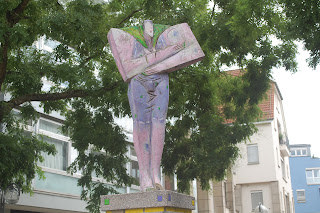








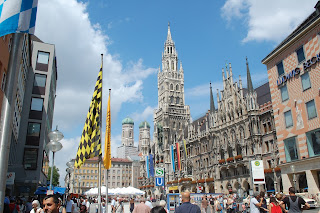




















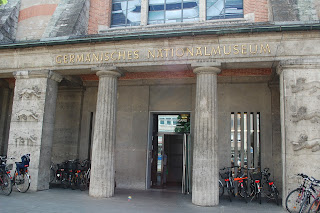
























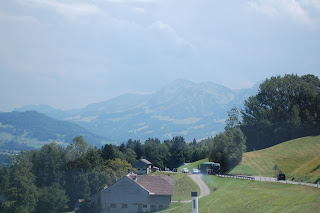













































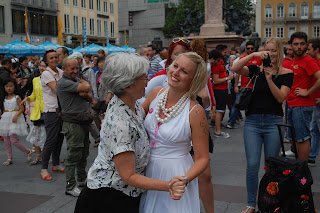




I really enjoyed all the art work and the comments.
ReplyDelete